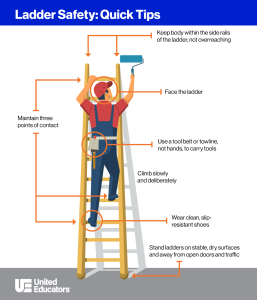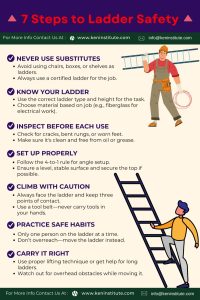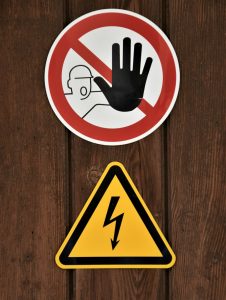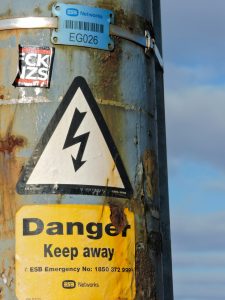Have you ever stopped to think about how electricity powers almost everything around you? It’s easy to take it for granted until something goes wrong.
Understanding basic electrical safety is not just important—it can protect you, your loved ones, and your home from serious harm. You’ll discover simple, practical tips that anyone can follow to stay safe around electricity. Keep reading, because knowing these basics could save you from accidents you never saw coming.

Credit: www.facebook.com
Electrical Hazards At Home
Electrical hazards at home can cause serious injuries or fires. Many people face risks daily without noticing them. Understanding these hazards helps keep your family safe. Identifying risks and danger zones is the first step in basic electrical safety.
Common Risks
- Overloaded power outlets can cause overheating and fires.
- Damaged cords expose wires, increasing shock risk.
- Wet hands or floors near electrical devices lead to shocks.
- Improper use of extension cords can cause sparks.
- Loose wiring inside walls may cause electrical fires.
Danger Zones
Certain areas in the home have higher electrical risks. Kitchens and bathrooms are wet environments with many appliances. Water and electricity do not mix well. Garages and basements often hold power tools and old wiring. Children’s play areas need special attention to avoid hazards. Outlets without safety covers increase shock chances, especially with kids around.
Safe Handling Of Electrical Devices
Handling electrical devices safely is crucial to protect yourself and your home from accidents. Every device you plug in or switch on carries a risk if not treated with care. Understanding how to manage these devices properly helps reduce hazards and keeps your environment secure.
Proper Use Of Appliances
Always read the manufacturer’s instructions before using any electrical appliance. Using devices as intended prevents damage and avoids dangerous situations. For instance, never use a kitchen appliance with wet hands; water and electricity don’t mix well.
Plug appliances directly into wall sockets instead of extension cords when possible. This reduces the risk of overheating and electrical fires. Have you checked if your appliances have safety certifications? Certified devices are generally safer and more reliable.
Avoiding Overloads
Overloading sockets is a common cause of electrical hazards. Plugging too many devices into one outlet can cause it to overheat and trip circuit breakers. You might feel tempted to connect multiple chargers and gadgets at once, but this can be risky.
Use power strips with built-in surge protectors to manage several devices safely. Always check the maximum load rating for your outlets and power strips. Ask yourself: are you aware of how much power your devices consume? Knowing this helps prevent dangerous overloads.
Protective Gear And Equipment
Protective gear and equipment play a critical role in electrical safety. These tools and clothing provide a barrier between you and electrical hazards. Proper use reduces the risk of shocks, burns, and other injuries. Let’s explore some essential protective items every worker should use.
Insulated Tools
Insulated tools are specially designed to protect against electrical currents. They feature non-conductive handles made from materials like rubber or plastic. These tools prevent electricity from passing through to your hands. Common examples include insulated screwdrivers, pliers, and wrenches. Always inspect tools for damage before use. Cracked insulation can compromise safety.
Safety Gloves And Footwear
Safety gloves and footwear are vital for personal protection. Electrical safety gloves are made from rubber and often have an outer leather layer. They shield your hands from electrical contact. Always choose gloves rated for the voltage level you’ll encounter.
Insulated footwear reduces the risk of electrical shocks through the feet. These shoes are made with non-conductive soles and materials. Ensure they fit well and are free from damage. Proper footwear enhances safety and provides comfort during long tasks.
Basic Electrical Safety Practices
Basic electrical safety practices protect you from accidents and injuries. These simple steps reduce risks when working with or near electricity. Following these rules keeps your home and workplace safe.
Turning Off Power
Always turn off the power before starting any electrical work. Use the main switch or circuit breaker to cut electricity. Confirm the power is off by testing switches or outlets. This step prevents electric shocks and injuries.
Checking For Damaged Wires
Inspect wires for cracks, frays, or exposed metal. Damaged wires can cause shorts, fires, or shocks. Replace or repair any faulty wiring before use. Use insulated tools and gloves to stay safe during inspection.
Emergency Response To Electrical Accidents
Electrical accidents can happen in the blink of an eye. Whether it’s a workplace mishap or an incident at home, knowing how to respond can make all the difference. Reacting quickly and correctly in emergencies can save lives and prevent further harm. But are you prepared to act when every second counts?
First Aid Steps
When someone suffers from an electrical shock, your first priority is safety. Do not touch the person if they are still in contact with the electrical source. Turn off the power supply immediately if it’s safe to do so.
Once the victim is no longer in contact with electricity, check their breathing and pulse. If they are unconscious and not breathing, start CPR right away. Ensure that someone else is calling for help while you administer first aid.
Burns are common in electrical accidents. Cool the affected area with clean, cold water but avoid ice. Cover the burns loosely with a sterile cloth to prevent infection. Never use ointments or creams on electrical burns as they can worsen the injury.
When To Call For Help
Electrical accidents can be deceptive. Even if the person appears fine, internal injuries or cardiac issues might develop later. Always call emergency services if the victim loses consciousness, has visible burns, or is experiencing irregular breathing.
If you’re unsure about the severity of the situation, it’s better to err on the side of caution. Medical professionals can assess for complications that might not be immediately visible. Remember, fast action can save lives.
Ask yourself: If this happened to someone you care about, would you know what to do? Preparation and knowledge are key to handling electrical emergencies effectively.

Credit: www.youtube.com
Childproofing Electrical Areas
Childproofing electrical areas is a crucial step to ensure the safety of your little ones. Curious hands can quickly turn everyday objects, like outlets and cables, into potential hazards. By taking a few simple precautions, you can create a safer environment and reduce the chances of accidents.
Outlet Covers
Exposed electrical outlets are like magnets for toddlers. Their small fingers or objects they play with might find their way into those openings. To prevent this, invest in high-quality outlet covers.
- Choose sliding or self-closing outlet covers. These allow you to use the outlet while keeping it secure when not in use.
- Ensure the covers fit snugly. Loose covers can easily be removed by curious kids.
- Avoid cheap plastic caps. They can be choking hazards if pulled out.
Think about this: Would you rather spend a few dollars on outlet covers or risk an unexpected trip to the emergency room?
Safe Cable Management
Messy cables not only look untidy but also pose tripping and electrical risks to children. Proper cable management can help safeguard your home while keeping it organized.
- Use cable organizers or cord sleeves to bundle loose wires together.
- Secure cables to walls or under furniture using adhesive clips or cable ties.
- Keep cords out of reach by tucking them behind furniture or using cable boxes.
Also, check for frayed or damaged cables. Replace them immediately—don’t wait for them to become a hazard. Imagine how much safer your home feels when cables are hidden and out of reach.
Routine Electrical Maintenance
Routine electrical maintenance is a key part of keeping your home or workplace safe. It helps prevent unexpected hazards and ensures your electrical systems run smoothly. By checking your electrical setup regularly, you can spot issues early before they turn into costly repairs or dangerous situations.
Inspection Tips
Start by looking for visible signs of wear like frayed wires, scorch marks, or loose outlets. These small details often reveal bigger problems hiding behind walls or inside electrical panels.
Test your circuit breakers to make sure they trip properly during overloads. If they don’t, it could mean your system isn’t protecting you as it should.
Check that all cords and plugs are intact and not overheating. Hot plugs can signal faulty connections that might lead to fires.
Ask yourself: when was the last time you inspected your electrical components? Regular checks every few months can save you from unexpected shocks—literally.
Hiring Professionals
Some electrical tasks require expert knowledge and tools. Don’t hesitate to call a licensed electrician if you notice anything unusual or if your maintenance goes beyond basic inspections.
Professionals can perform thorough testing, pinpoint hidden issues, and handle complex repairs safely. Their experience reduces risks and ensures compliance with safety codes.
When choosing an electrician, look for certifications and positive reviews. A trustworthy pro will explain the work clearly and answer your questions without rushing.
Think about it: would you risk your safety or save a few bucks by skipping professional help? Investing in experts protects you and your property in the long run.

Credit: www.facebook.com
Frequently Asked Questions
What Is Basic Electrical Safety?
Basic electrical safety involves precautions to prevent electrical hazards. Always use insulated tools, avoid water near electrical equipment, and wear protective gear.
Why Is Electrical Safety Important?
Electrical safety prevents injuries, fatalities, and damage to property. It ensures safe operation of equipment and protects workers from risks.
How Can I Protect Myself From Electrical Hazards?
To protect yourself, avoid damaged wires, use grounded outlets, and follow safety guidelines. Always turn off power before repairs.
What Are Common Electrical Safety Practices?
Common practices include using surge protectors, inspecting equipment regularly, and keeping flammable items away from electrical sources.
Conclusion
Basic electrical safety keeps everyone safe at home and work. Always check wires and plugs for damage. Never touch electrical devices with wet hands. Use tools designed for electrical work only. Stay away from exposed wires and faulty outlets. Simple habits prevent serious accidents and injuries.
Respect electricity’s power; it can be dangerous. Keep learning and practicing safety every day. Safety is not just a rule—it’s a habit. Stay alert, stay safe, and protect yourself and others.








